I don't know about you, but aside from the entertainment value, I love finding mistakes while watching TV shows or movies.
Some mistakes are way too technical for me to notice, but it's the simple mistakes that bother me the most. For example, picture a scene where the hero walks on a sidewalk next to a busy street. When the camera looks at him from ground level, a green car slowly passes next to him. As the camera slowly rises above him in what seems to be a single shot, that same green car drives by him again.
Anachronisms are the other kind of error I spot while watching shows. You may not be familiar with the word, but I'd be willing to bet a nickel you'll know it when you see it.

For example, you're watching a movie that takes place during the Middle Ages. All the actors and set designs have been designed to fit the period. Halfway through a scene, you see a Medieval lady pull out a digital camera.
That's an anachronism.
There are subtle things around us in our everyday lives that seem to be anachronistic such as a manual pencil sharpener, Wite-Out® correction fluid, and a keyboard tray.
Articulated keyboard trays evolved at a slower pace than other work surface products in an office environment. The development of a keyboard tray is reactionary: desk manufacturers roll out new versions of their desk, and keyboard trays need to be developed to work with those new desks.
Let's take a step back and talk about the evolution of the articulated keyboard tray.
Moving Forward with Moving Type
Want to have a little fun? Find a manual typewriter and place it in front of a person around 25 years old. Assign them the task of writing a letter.
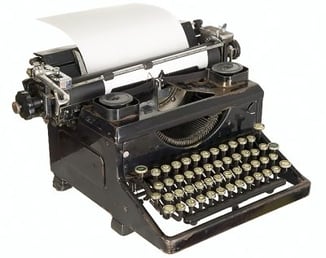
The expression on their face would be Facebook worthy.
Millennials are the first generation of people who never knew a world without computers. Boomlets have never known a world without computers or cell phones. Asking them to use a typewriter is akin to asking a caveman run a copier.

Before typewriters, office assistants took notes in longhand. The fastest a person could write was around 30 words per minute.
The wireless keyboards of today had an auspicious beginning as a typewriter. Invented in 1867, but not widely used in business until the 1880s, typewriters represented a faster way of producing business documents.
Although typewriters played an essential role in everyday business, they still took up a lot of room. Eventually, developing a separate table for the typewriter became necessary.
There were some advancements to the typing table such as folded side surfaces which held the documents and wheels to move the table around. Other than some aesthetics, the typing table didn't change very much.
Slowly over time, manual typewriters became electric. Eventually, electric typewriters evolved into desktop computers.
As time and technology progressed, word processors and desktop computers became the go-to tool for nearly all offices in the mid-1990s.
The Transition to Keyboard Trays
As we turned towards the digital world, people began using articulated keyboard trays for many reasons. However, two reasons stand out among the others.
Real Estate
As the business world entered the computer age, free space on the desktop became valuable. The reason? The large computer monitors.
Desks stayed the same size, but the early monitors demanded a lot of room. There was only one way to obtain that extra space: a keyboard tray.
A shelf slid out from underneath the desktop holding a keyboard thereby saving valuable free space. The shelf usually was no wider than the size of a keyboard.
Extra space is a significant benefit articulated keyboard trays provide. There is, however, a more important reason behind the growing popularity of trays.
One Size Doesn't Fit All
If you had to guess the industry standard desk height, would you know? I didn't until researching for this article.
If you ask a desk manufacturer, they'll say it's 29-inches. Standard sizes are essential for any manufacturer. Instead of a variety of heights requiring a change-out of machinery, they can bang out large numbers of desks in an economical fashion.
Why 29-inches? Because that's the height of the commonly used 3-drawer filing cabinets. Specifically, the need to have those cabinets slide underneath a desk is why manufacturers of office furniture adopted 29-inches.
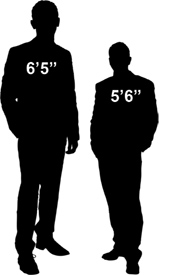
There's one problem with a desktop height of 29-inches: it's the ideal height for a person who's around 6' 1" tall.
That doesn't seem like a problem until you realize that in the US, the average man is 5' 8" tall and the average woman is 5' 4".
Putting it another way, desk manufacturers use a standard height desk that fits around 5% of our population!
Check out the image to the right. If the 5' 6" person sat at the 6' 5" person's desk, what happens? The shorter person ends up dealing with a keyboard level with their chest.
The following chart shows the proper desk heights for people.
[table id=10 /]
There's a range of 9" from shortest to tallest. Since
making custom-sized desks is impractical for office furniture manufacturers, people needed to customize desks.
Using a height adjustable desk solves most of the problems. But using an articulated keyboard tray with a standing desk virtually guarantees correct ergonomic heights.
Times Changed
For many years, keyboard trays didn't change. They didn't need to. The way people worked on PCs didn't require a computer mouse.
Created in 1981 for IBM compatible computers, MS-DOS required users to open, navigate, and access files on their system typing on a command line. A mouse wasn't needed. (Note: Macintosh users back then used a mouse, but Mac computers were used exclusively for graphic design and desktop publishing.)
Things changed in the latter part of 1995. Microsoft introduced Windows 95 and changed everything. Instead of working off the command line, people needed a mouse to work with icons on their PCs. Because of this, keyboard trays started appearing with an extended board on one side giving room to the mouse.
Work Station Evolution
For nearly two decades, desks with keyboard tray system became ubiquitous. The look and use of trays changed with the evolution of two technologies.
Flat LCD Monitors
Early computer monitors used cathode ray tubes (CRTs), similar to technology used in older TVs with one difference: the old CRT monitors on PC systems displayed monochromatic images.
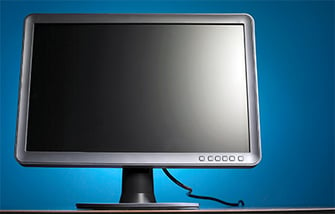
The rivalry with Apple pushed PC monitor manufacturers towards adapting the color graphics adapter in 1981. As the need for higher definition monitors grew, so did the size and power consumption of the CRT monitors.
The advent of liquid-crystal display (LCD) technology flattened monitors. Using LCD flat screens meant not having a bulky, energy-sucking CRT monitor taking up over half of a work surface, thereby returning several cubic feet of space.
Adjustable Height Desks
At first, the theory of having the ability to alter the desk height seemed to eliminate the need for an articulated keyboard tray. However, two factors proved that theory wrong:
- The inability to incorporate a negative keyboard tilt
- Keyboards used up valuable workspace
Articulated keyboard trays proved their worth during the advent of height adjustable desks.
Advantages of an Articulated Keyboard Tray
There are significant advantages to using a keyboard tray.
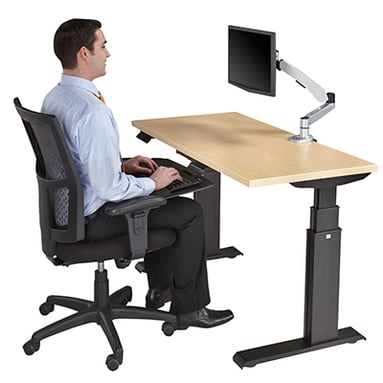
Customize: You adjust the settings of the keyboard tray to match your size and the way you sit. Even if sharing a desk, it's easy to readjust the tray to fit.
Space: Articulated keyboard trays provide a considerable advantage if you work in a small workstation.
Money: Typically, quality meant spending a lot of money. Not so with articulating keyboard trays. Good trays start at $150.
Efficiency: Eliminating awkward reaching or feeling uncomfortable while working allows you to work faster.
Flexibility: There are many options available for keyboard trays. If you prefer having your keyboard and mouse on the same level or want storage for pens or pencils, there are many styles to fit your needs.
Ergonomics: Even though you're able to adjust the height of your standing desk, a correct ergonomic height may not be possible. Using an adjustable keyboard tray allows you to fine tune the height.
Installation: Installing a tray is relatively straightforward. Articulating keyboard trays work with all desks and attach using an assortment of screws.
Positioning: Taking the ergonomic benefit a little further, an articulating keyboard tray puts your mouse and keyboard in a neutral position with your elbows at 90º.
Tilting Feature: There is one thing that a keyboard placed on the surface of a desk cannot do: tilt. The extendable keyboard tray has a tilting feature allowing you to create either a positive or negative tilt improving ergonomics.
Wrist Rest/Support: Working with its tilting feature are wrist supports for the keyboard and mouse. The job of a wrist rest is keeping your wrists in a neutral position reducing muscular tension in arms, shoulders, and backs.
Carpal Tunnel Syndrome: With an increase of cases of carpal tunnel, using an articulated keyboard tray helps prevent occurrences of hand and wrist problems. How?
Preventing Carpal Tunnel Syndrome
Repetitive hand motion creates a strain on the median nerve in the wrist which results in carpal tunnel syndrome.
A major symptom of carpal tunnel is tingling or numbness in your hand and arm caused by pinching of the median nerve in your hand.
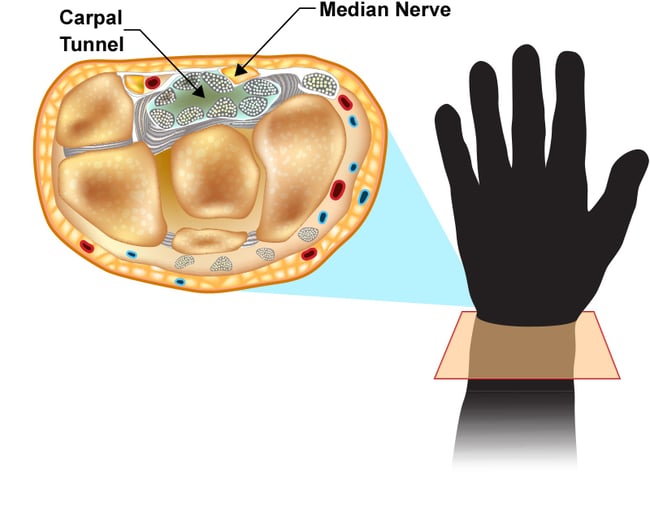
Perhaps the most effective way to reduce the risk of carpal tunnel is being aware of the position of your wrist while typing on a keyboard.

Keeping your wrist and forearm in a straight line opens the carpal tunnel and allows the median nerve and tendons to work correctly.
Keeping your elbows at 90º places your wrists in a neutral position. Using this position, along with a wrist rest, consider the following tips help prevent carpal tunnel.
- Avoid bending or curling your wrists while sleeping
- Keeping your hands warm preventing stiffness. If you work in a cool location, consider using fingerless gloves.
- Loosen your grip when working with your hands such as holding a pencil or pen too tight or pounding your fingers on the keyboard while typing.
- Take quick breaks frequently. This gives you a chance to rest your hands by changing their position.
- Remember to stretch your wrists, hands, and fingers as often as you can.
- Improve your body mechanics and posture while working at your desk.
Disadvantages of an Articulated Keyboard Tray
Articulated keyboard trays aren't for everyone. When deciding to use a tray, don't allow your decision to be influenced by someone else's opinions.
Price: Don't buy the first articulated keyboard tray you find. Do your research and choose wisely. Make sure you find a keyboard tray fits your desk and meets your needs.
Acclimation: A person can't just sit down at a keyboard tray and work efficiently. It takes time to adjust and get used to the tray system properly.
Distance: Using an articulated keyboard tray means a longer reach for items on your desk that fall into 3 Reach Zones.
Instability: Some less expensive trays aren't stable, which leads to bouncing and shaking as you type.
Space: An articulated keyboard tray takes up space underneath a desk. Depending on your height, it may bang your knees.
Consider how much room there is to work your mouse. Attached mouse trays aren't large. If your job requires a lot of mouse movement, you won't find much room. In case you need more space for your mouse, look for companies that feature custom sizes.
Myriad of Keyboard Tray Choices
Just as there's more than one way to bake a cake, there are a variety of keyboard tray styles to choose from, including track, trackless, short, and wall mount. Styles include a tray with a drawer, just a tray, and a tray with a mouse platform.
Tray platforms are made in four ways:

Phenolic Resin: Phenolic resin is a synthetic resin made from bonding of a phenol and formaldehyde. These resins are one of the most versatile and popular high-volume resins systems.
Invented by Dr. Leo Baekeland in 1907, phenolic resins offer exceptional heat resistance, surface hardness, keeps its original size when exposed to humidity and temperature, chemical resistance, and has electrical insulating properties.
Laminated Wood: If you want your desk and tray to match, then try one made from laminated wood. These are thick and very stable, but heavier and harder to adjust.
Plastic: Plastic trays are the least expensive but not as widely used anymore.
Metal: Metal keyboard trays are almost indestructible, stable, and have a lower profile. However, expect to pay a little more money to buy one.
Selecting the right tray for you shouldn't be a guess. If you're considering buying one, search for a resource that provides a comparison of the different kinds. (For example, RightAngle Products shares this helpful tool.)
Using a Keyboard Tray
As you begin working on an articulated keyboard tray, learn the proper ergonomic layout. Remember, the idea is to position yourself in such a way that causes the least stress to your body while working in a comfortable pose.
Here's a short video illustrating the options an articulated keyboard tray offers:
Ergonomics
There are subtle differences between working with or without an articulated keyboard tray and maintaining a proper ergonomic posture.
Although you're working at different levels, fundamentally there should be no difference in elbow angle and head level.
For example, here's an illustration for using a standing desk without a keyboard tray. The diagram also provides an example of how much workspace a keyboard tray uses.
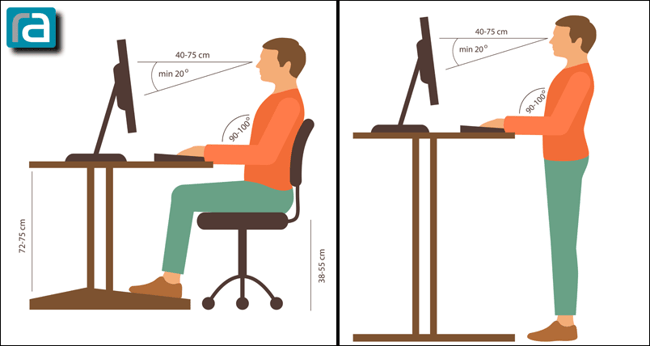
Similarly, here's an illustration for using an articulated keyboard tray with a standing desk. Notice too how much workspace the tray saves.
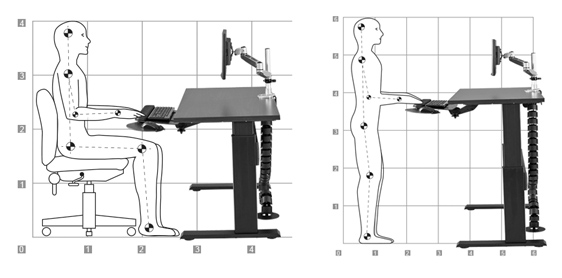
3 Reach Zones
A key aspect of ergonomics is to work in neutral: keeping your body under minimal stress by aligning it while at your desk.
Placing items on the desktop at the right distance maintains that alignment. Achieving a proper range of motion for your hands and arms is to use a 3-Reach Zone model. Specific actions define each zone.
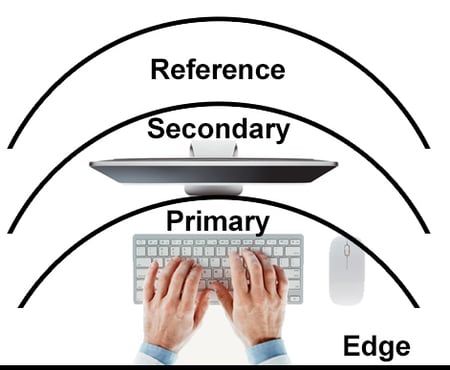
The 3-Reach Zones are:
Primary: The primary zone is also called the neutral reach zone. It's the area that falls within easy reach of your bent elbow, where you perform the most work and is the most comfortable. The primary region contains all needed items, such as your keyboard, mouse, pen, and paper.
Secondary: The secondary zone is the area reached by extending your arms. Store items so they're within fingertip reach. This zone contains things needed less frequently such as folders, tools, or books. These items are still easy to reach but are outside the primary area.
Reference: The reference zone contains items that you reach by bending over at the waist and extending your elbow. Items in the reference zone are rarely needed. Use this zone for storage only for things like reference materials.
So, Are Keyboard Trays Necessary?
The answer to that question is simple: no, keyboard trays aren't necessary. They are, however, a good tool for preventing carpal tunnel.
As much as height adjustable desks improved workplace ergonomics, they still have their limits. For the most part, keyboard trays offset those limits.
When used correctly, the combination of a keyboard tray and adjustable height desk results in a robust ergonomic platform. Despite a changing desktop, keyboard trays remain a viable option in today's computing world.

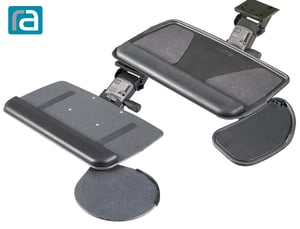
COMMENTS